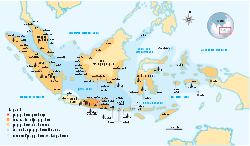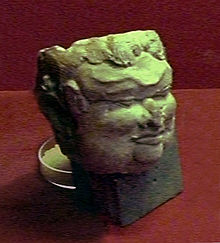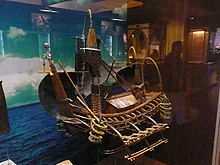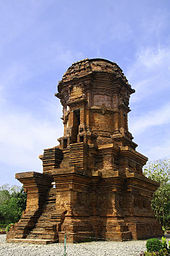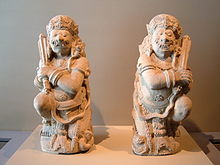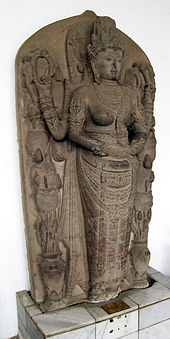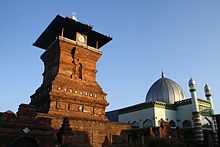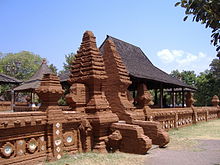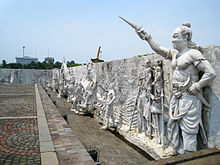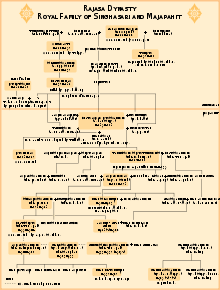- Majapahit
-
Majapahit Empire
Karaton Mojopahit
Kerajaan Majapahit← 
1293–1527  →
→Surya Majapahit¹
Extent of Majapahit influence based on the Nagarakertagama; the notion of such Javanese depictions is considered conceptual.[1] Capital Majapahit, Wilwatikta (modern Trowulan) Language(s) Old Javanese (main), Sanskrit (religious) Religion Kejawen, Hinduism, Buddhism, Animism Government Monarchy Raja - 1295-1309 Kertarajasa Jayawardhana - 1478-1498 Girindrawardhana History - Coronation November 10, 1293 - Demak takeover 1527 Currency Native gold and silver coins, Kepeng (coins imported from China and later produced locally [2]) ¹ Surya Majapahit (The Sun of Majapahit) is the emblem commonly found in Majapahit ruins. It served as the symbol of the Majapahit empire This article is part of the
History of Indonesia series
See also:
Timeline of Indonesian History Prehistory Early kingdoms Kutai (4th century) Tarumanagara (358–669) Kalingga (6th–7th century) Srivijaya (7th–13th centuries) Sailendra (8th–9th centuries) Sunda Kingdom (669–1579) Medang Kingdom (752–1045) Kediri (1045–1221) Singhasari (1222–1292) Majapahit (1293–1500) The rise of Muslim states Spread of Islam (1200–1600) Sultanate of Ternate (1257–present) Malacca Sultanate (1400–1511) Sultanate of Demak (1475–1548) Aceh Sultanate (1496–1903) Sultanate of Banten (1526–1813) Mataram Sultanate (1500s–1700s) European colonization The Portuguese (1512–1850) Dutch East India Co. (1602–1800) Dutch East Indies (1800–1942) The emergence of Indonesia National awakening (1908–1942) Japanese occupation (1942–45) National revolution (1945–50) Independent Indonesia Liberal democracy (1950–57) Guided Democracy (1957–65) Start of the New Order (1965–66) The New Order (1966–98) Reformasi era (1998–present) Majapahit was a vast archipelagic empire based on the island of Java (modern-day Indonesia) from 1293 to around 1500. Majapahit reached its peak of glory during the era of Hayam Wuruk, whose reign from 1350 to 1389 marked by conquest which extended through Southeast Asia. His achievement is also credited to his prime minister, Gajah Mada. According to the Nagarakretagama (Desawarñana) written in 1365, Majapahit was an empire of 98 tributaries, stretching from Sumatra to New Guinea;[3] consisting of present day Indonesia, Singapore, Malaysia, Brunei, southern Thailand, the Philippines, and East Timor, although the true nature of Majapahit sphere of influence is still the subject of studies among historians.
Majapahit was one of the last major empires of the region and is considered to be one of the greatest and most powerful empires in the history of Indonesia and Southeast Asia, one that is sometimes seen as the precedent for Indonesia's modern boundaries.[4] Its influence extended beyond the modern territory of Indonesia and has been the subject of many studies.[5] German orientalist Berthold Laufer suggested that maja came from the Javanese name of an Indonesian tree.[6]
Contents
Historiography
Little physical evidence of Majapahit remains,[7] and some details of the history are rather abstract.[8] The main sources used by historians are: the Pararaton ('Book of Kings') written in the Kawi language and Nagarakertagama in Old Javanese.[9] Pararaton is focused upon Ken Arok (the founder of Singhasari) but includes a number of shorter narrative fragments about the formation of Majapahit. Nagarakertagama, is an old Javanese epic poem written during the Majapahit golden age under the reign of Hayam Wuruk after which some events are covered narratively.[8] There are also some inscriptions in Old Javanese and Chinese.
The Javanese sources incorporate some poetic mythological elements, and scholars such as C. C. Berg, a Dutch nationalist, have considered the entire historical record to be not a record of the past, but a supernatural means by which the future can be determined.[10] Despite Berg's approach, most scholars do not accept this view, as the historical record corresponds with Chinese materials that could not have had similar intention. The list of rulers and details of the state structure show no sign of being invented.[8]
Ming Dynasty admiral Zheng He visited Majapahit. Zheng He's translator Ma Huan wrote a detailed description about Majapahit and where the king of Java lived.[11] New findings in April 2011, indicate the Majapahit capital was much larger than previously believed after some artifacts were uncovered.[12]
History
Formation
The statue of Harihara, the god combination of Shiva and Vishnu. It was the mortuary deified portrayal of Kertarajasa. Originally located at Candi Simping, Blitar and the statue is now preserved at the National Museum of Indonesia.
After defeating the Melayu Kingdom[13] in Sumatra in 1290, Singhasari became the most powerful kingdom in the region. Kublai Khan, the Great Khan of the Mongol Empire and the Emperor of the Mongol Yuan Dynasty, challenged Singhasari by sending emissaries demanding tribute. Kertanegara, the last ruler of Singhasari, refused to pay the tribute, insulted the Mongol envoy and challenged the Khan instead. As the response, in 1293, Kublai Khan sent a massive expedition of 1,000 ships to Java.
By that time, Jayakatwang, the Adipati (Duke) of Kediri, a vassal state of Singhasari, had usurped and killed Kertanagara. After being pardoned by Jayakatwang with the aid of Madura's regent, Arya Wiraraja; Raden Wijaya, Kertanegara's son-in-law, was given the land of Tarik timberland. He then opened that vast timberland and built a new village there. The village was named Majapahit, which was taken from a fruit name that had a bitter taste in that timberland (maja is the fruit name and pahit means bitter). When the Mongolian Yuan army sent by Kublai Khan arrived, Wijaya allied himself with the army to fight against Jayakatwang. Once Jayakatwang was destroyed, Raden Wijaya forced his allies to withdraw from Java by launching a surprise attack.[14] Yuan's army had to withdraw in confusion as they were in hostile territory. It was also their last chance to catch the monsoon winds home; otherwise, they would have had to wait for another six months on a hostile island.
In AD 1293, Raden Wijaya founded a stronghold with the capital Majapahit. The exact date used as the birth of the Majapahit kingdom is the day of his coronation, the 15th of Kartika month in the year 1215 using the Javanese çaka calendar, which equates to November 10, 1293. During his coronation he was given formal name Kertarajasa Jayawardhana. The new kingdom faced challenges. Some of Kertarajasa's most trusted men, including Ranggalawe, Sora, and Nambi rebelled against him, though unsuccessfully. It was suspected that the mahapati (equal with prime minister) Halayudha set the conspiracy to overthrow all of the king's opponents, to gain the highest position in the government. However, following the death of the last rebel Kuti, Halayudha was captured and jailed for his tricks, and then sentenced to death.[14] Wijaya himself died in AD 1309.
According to tradition, Wijaya's son and successor, Jayanegara was notorious for immorality. One of his sinful acts was his desire on taking his own stepsisters as wives. He was entitled Kala Gemet, or "weak villain". Approximately during Jayanegara's reign, the Italian Friar Odoric of Pordenone visited Majapahit court in Java. In AD 1328, Jayanegara was murdered by his doctor, Tanca. His stepmother, Gayatri Rajapatni, was supposed to replace him, but Rajapatni retired from court to become a Bhikkhuni. Rajapatni appointed her daughter, Tribhuwana Wijayatunggadewi, or known in her formal name as Tribhuwannottungadewi Jayawishnuwardhani, as the queen of Majapahit under Rajapatni's auspices. Tribhuwana appointed Gajah Mada as the Prime Minister in 1336. During his inauguration Gajah Mada declared his Sumpah Palapa, revealing his plan to expand Majapahit realm and building an empire. During Tribhuwana’s rule, the Majapahit kingdom grew much larger and became famous in the area. Tribhuwana ruled Majapahit until the death of her mother in AD 1350. She abdicated the throne in favour of her son, Hayam Wuruk.
Golden age
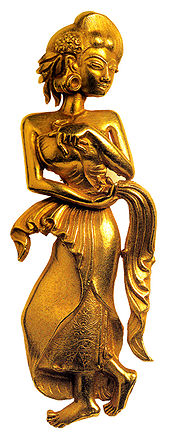 The graceful Bidadari Majapahit, golden celestial apsara in Majapahit style perfectly describes Majapahit as "the golden age" of the archipelago.
The graceful Bidadari Majapahit, golden celestial apsara in Majapahit style perfectly describes Majapahit as "the golden age" of the archipelago.
Hayam Wuruk, also known as Rajasanagara, ruled Majapahit in AD 1350–1389. During this period, Majapahit attained its peak with the help of prime minister, Gajah Mada. Under Gajah Mada's command (AD 1313–1364), Majapahit conquered more territories and become the regional power. According to the book of Nagarakertagama pupuh (canto) XIII and XIV mentioned several states in Sumatra, Malay Peninsula, Borneo, Sulawesi, Nusa Tenggara islands, Maluku, New Guinea, and some parts of Philippines islands as under Majapahit realm of power. This source mentioned of Majapahit expansions has marked the greatest extent of Majapahit empire.
Next to launching naval and military expeditions, the expansion of Majapahit Empire also involved diplomacy and alliance. Hayam Wuruk decided, probably for political reasons, to take princess Citra Rashmi (Pitaloka) of neighboring Sunda Kingdom as his consort.[15] The Sundanese took this proposal as an alliance agreement. In 1357 the Sunda king and his royal family came to Majapahit, to accompany and marry his daughter with Hayam Wuruk. However Gajah Mada saw this event as an opportunity to demand Sunda's submission to Majapahit overlordship. The skirmish between the Sunda royal family and the Majapahit troops on Bubat square were unevitable. Despite the courageous resistance, the royal family were overwhelmed and decimated. Almost whole of the Sundanese royal party were viciously massacred.[16] Tradition mentioned that the heartbroken Princess committed suicide to defend the honour of her country.[17] The Battle of Bubat or Pasunda Bubat tragedy become the main theme of Kidung Sunda, also mentioned in Carita Parahyangan and Pararaton, however it was never mentioned in Nagarakretagama.
The Nagarakertagama, written in 1365 depict a sophisticated court with refined taste in art and literature, and a complex system of religious rituals. The poet describes Majapahit as the centre of a huge mandala extending from New Guinea and Maluku to Sumatra and Malay Peninsula. Local traditions in many parts of Indonesia retain accounts in more or less legendary form from 14th century Majapahit's power. Majapahit's direct administration did not extend beyond east Java and Bali, but challenges to Majapahit's claim to overlordship in outer islands drew forceful responses.[18]
In 1377, a few years after Gajah Mada's death, Majapahit sent a punitive naval attack against a rebellion in Palembang,[4] contributing to the end of the Srivijayan kingdom. Gajah Mada's other renowned general was Adityawarman[citation needed], known for his conquest in Minangkabau.
The nature of the Majapahit empire and its extent is subject to debate. It may have had limited or entirely notional influence over some of the tributary states in included Sumatra, the Malay Peninsula, Kalimantan and eastern Indonesia over which of authority was claimed in the Nagarakertagama.[19] Geographical and economic constraints suggest that rather than a regular centralised authority, the outer states were most likely to have been connected mainly by trade connections, which was probably a royal monopoly.[4] It also claimed relationships with Champa, Cambodia, Siam, southern Burma, and Vietnam, and even sent missions to China.[4]
Although the Majapahit rulers extended their power over other islands and destroyed neighboring kingdoms, their focus seems to have been on controlling and gaining a larger share of the commercial trade that passed through the archipelago. About the time Majapahit was founded, Muslim traders and proselytizers began entering the area.
Decline
Following Hayam Wuruk's death AD 1389, Majapahit power entered a period of decline with conflict over succession. Hayam Wuruk was succeeded by the crown princess Kusumawardhani, who married a relative, Prince Wikramawardhana. Hayam Wuruk also had a son from his previous marriage, crown prince Wirabhumi, who also claimed the throne. A civil war, called Paregreg, is thought to have occurred from 1405 to 1406,[8] of which Wikramawardhana was victorious and Wirabhumi was caught and decapitated. The civil war has weakened Majapahit grip on its outer vassals and colonies.
During the reign of Wikramawardhana, the series of Ming armada naval expeditions led by Zheng He, a Muslim Chinese admiral, arrived in Java for several times spanned the period from 1405 to 1433. By 1430 Zheng He's expeditions has established Muslim Chinese and Arab communities in northern ports of Java such as in Semarang, Demak, Tuban, and Ampel, thus Islam began to gain foothold on Java's northern coast.
Wikramawardhana ruled to 1426 AD and was succeeded by his daughter Suhita, who ruled from 1426 to 1447 AD. She was the second child of Wikramawardhana by a concubine who was the daughter of Wirabhumi. In 1447, Suhita died and was succeeded by Kertawijaya, her brother. He ruled until 1451 AD. After Kertawijaya died, Bhre Pamotan became a king with formal name Rajasawardhana and ruled at Kahuripan. He died in 1453 AD. A three-year kingless period was possibly the result of a succession crisis. Girisawardhana, son of Kertawijaya, came to power 1456. He died in 1466 AD and was succeeded by Singhawikramawardhana. In 1468 AD Prince Kertabhumi rebelled against Singhawikramawardhana promoting himself king of Majapahit.
In western part of the crumbling empire, Majapahit found itself unable to control the rising power of the Sultanate of Malacca that in mid 15th century began to gain effective control of Malacca strait and expands its influence to Sumatra. Several other former Majapahit vassals and colonies began to released themself from Majapahit domination and suzerainty.
The model of Majapahit ship display in Muzium Negara, Kuala Lumpur.
Singhawikramawardhana moved the Kingdom’s capital further inland to Daha (the former capital of Kediri kingdom) and continued his rule until he was succeeded by his son Ranawijaya in 1474 AD. In 1478 AD he defeated Kertabhumi and reunited Majapahit as one Kingdom. Ranawijaya ruled from 1474 AD to 1519 AD with the formal name Girindrawardhana. Nevertheless, Majapahit's power had declined through these dynastic conflicts and the growing power of the north-coastal kingdoms in Java.
Dates for the end of the Majapahit Empire range from 1478 (that is, 1400 Saka, the ends of centuries being considered a time when changes of dynasty or courts normally ended[20]) to 1527. The year is marked among Javanese today with candrasengkala "sirna ilang kertaning bumi" (the wealth of earth disappeared and diminished) (sirna = 0, ilang = 0, kerta = 4, bumi = 1). According Jiyu and Petak inscription, Ranawijaya claimed that he already defeat Kertabhumi [21] and move capital to Daha. This event to led the war between Sultanate of Demak and Daha, since Demak ruler was the descendants of Kertabhumi. The battle was won by Demak in 1527.[22] A large number of courtiers, artisans, priests, and members of the royalty moved east to the island of Bali. The refugees probably fled to avoid Demak retribution for their support for Ranawijaya against Kertabhumi.
With the fall of Daha crushed by Demak in 1527, the Muslim emerging forces finally defeated the remnants of the Majapahit kingdom in the early 16th century.[23] Demak under the leadership of Raden (later crowned as Sultan) Patah (Arabic name: Fatah) was acknowledged as the legitimate successor of Majapahit. According to Babad Tanah Jawi and Demak tradition, the source of Patah's legitimacy was because their first sultan, Raden Patah, was the son of Majapahit king Brawijaya V with a Chinese concubine. Another argument supports Demak as the successor of Majapahit; the rising Demak sultanate was easily accepted as the nominal regional ruler, as Demak was the former Majapahit vassal and located near the former Majapahit realm in Eastern Java.
Demak established itself as the regional power and the first Islamic sultanate in Java. After the fall of Majapahit, the Hindu kingdoms in Java only remained in Blambangan on eastern edge and Pajajaran in western part. Gradually Hindu communities began to retreat to mountain ranges in East Java and also to neighboring island of Bali. A small enclave of Hindu communities still remain in Tengger mountain range.
Culture, art and architecture
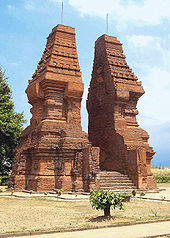 Wringin Lawang, the 15.5 meter tall red brick split gate. Located at Trowulan. Believed to be the entrance of an important compound in Majapahit capital.
Wringin Lawang, the 15.5 meter tall red brick split gate. Located at Trowulan. Believed to be the entrance of an important compound in Majapahit capital.
"Of all the buildings, none lack pillars, bearing fine carvings and coloured" [Within the wall compounds] "there were elegant pavilions roofed with aren fibre, like the scene in a painting... The petals of the katangga were sprinkled over the roofs for they had fallen in the wind. The roofs were like maidens with flowers arranged in their hair, delighting those who saw them".
— Description of the Majapahit capital from the Old Javanese epic poem Nagarakertagama.
The main event of the administrative calendar took place on the first day of the month of Caitra (March–April) when representatives from all territories paying tax or tribute to Majapahit came to the capital to pay court. Majapahit's territories were roughly divided into three types: the palace and its vicinity; the areas of east Java and Bali which were directly administered by officials appointed by the king; and the outer dependencies which enjoyed substantial internal autonomy.[24]
The capital (Trowulan) was grand and known for its great annual festivities. Buddhism, Shaivism, and Vaishnavism were all practiced, and the king was regarded as the incarnation of the three. The Nagarakertagama does not mention Islam, but there were certainly Muslim courtiers by this time.[4]
Although brick had been used in the candi of Indonesia's classical age, it was Majapahit architects of the 14th and 15th centuries who mastered it.[25] Making use of a vine sap and palm sugar mortar, their temples had a strong geometric quality. The example of Majapahit temples are Brahu temple in Trowulan, Pari in Sidoarjo, Jabung in Probolinggo, and Surawana temple near Kediri. Some of the temples are dated from earlier period but renovated and expanded during Majapahit era, such as Penataran, the largest temple in East Java dated back to Kediri era. This temple was identified in Nagarakretagama as Palah temple and reported being visited by King Hayam Wuruk during his royal tour across East Java.
Some of typical architectural style are believed to be developed during Majapahit era; such as tall and slender roofed red brick gate commonly called as kori agung or paduraksa, and also split gate of candi bentar. The large split gate of Wringin Lawang located at Jatipasar, Trowulan, Mojokerto, East Java, is one of the oldest and the largest surviving candi bentar dated from Majapahit era. The candi bentar took shape of typical Majapahit temple structure — consists of three parts; foot, body and tall roof — evenly split into two mirroring structures to make a passage in the center for people to walk through. This type of split gate has no doors and provides no real defensive purpose but narrowing the passage. It was probably only serve the ceremonial and aesthetic purpose, to create the sense of grandeur, before entering the next compound through tall roof paduraksa gate with enclosed door. The example of kori agung or paduraksa style gate is the elegant Bajang Ratu gate richly decorated with Kala demon, cyclops and also the bas-relief telling the story of Sri Tanjung. Those typical Majapahit architectural style has deeply influenced the Javanese and Balinese architecture of later period. The Majapahit Terracotta art also flourished in this period. Significant numbers of terracotta artifacts were discovered in Trowulan. The artifacts ranges from human and animal figurines, water containers, piggy banks, architectural ornaments, to pipes and roof tiles.
"....the King [of Java] has subject to himself seven crowned kings. [Yet] his island is populous, and is the second best of all island that exist.... The king of this island has a palace which is truly marvelous. For it is very great, the stairs and palace interior were coated with gold and silver, even the roof were gilded with gold. Now the Great Khan of China many a time engaged in war with this king; but this king always vanquished and get the better of him."
— Description of Majapahit by Mattiussi (Friar Odoric of Pordenone).[26]
The first European record about Majapahit came from the travel log of the Italian Mattiussi, a Franciscan monk. In his book: "Travels of Friar Odoric of Pordenone", he visited several places in today's Indonesia: Sumatra, Java, and Banjarmasin in Borneo, between 1318-1330. He was sent by the Pope to launch a misson into the Asian interiors. In 1318 he departed from Padua, crossed the Black Sea into Persia, all the way across Calcutta, Madras, and Srilanka. He then headed to Nicobar island all the way to Sumatra, before visiting Java and Banjarmasin. He returned to Italy by land through Vietnam, China, all the way through the silkroad to Europe in 1330.
In his book he mentioned that he visited Java without explaining the exact place he had visited. He said that king of Java ruled over seven other kings (vassals). He also mentioned that in this island was found a lot of clove, cubeb, nutmeg and many other spices. He mentioned that the King of Java had an impressive, grand, and luxurious palace. The stairs and palace interior were coated with gold and silver, and even the roof were gilded. He also recorded that the kings of the Mongol has repeatedly tried to attack Java, but always ended up in failure and managed to be sent back to the mainland. The Javanese kingdom mentioned in this record is Majapahit, and the time of his visit is between 1318-1330 during the reign of Jayanegara.
In later period near the fall of Majapahit, the art and architecture of Majapahit witnessed the revival of indigenous native Austronesian megalithic architectural elements, such as Sukuh and Cetho temples on western slopes of Mount Lawu. Unlike previous Majapahit temples that demonstrate typical Hindu architecture of high-rise towering structure, the shape of these temples are step pyramid, quite similar to Mesoamerican pyramids. The stepped pyramid structure called Punden Berundak (stepped mounds) is a common megalithic structure during Indonesian prehistoric era before the adoption of Hindu-Buddhist culture.
Economy
 Majapahit Terracotta Piggy Bank, 14-15 century AD Trowulan, East Java. (Collection of National Museum of Indonesia, Jakarta)
Majapahit Terracotta Piggy Bank, 14-15 century AD Trowulan, East Java. (Collection of National Museum of Indonesia, Jakarta)
Taxes and fines were paid in cash. Javanese economy had been partly monetised since the late 8th century, using gold and silver coins. In about the year 1300, in the reign of Majapahit's first king, an important change took place: the indigenous coinage was completely replaced by imported Chinese copper cash. About 10,388 ancient Chinese coins weighing about 40 kg were even unearthed from the backyard of a local commoner in Sidoarjo in November 2008. Indonesian Ancient Relics Conservation Bureau (BP3) of East Java verified that those coins dated as early as Majapahit era.[27] The reason for using foreign currency is not given in any source, but most scholars assume it was due to the increasing complexity of Javanese economy and a desire for a currency system that used much smaller denominations suitable for use in everyday market transactions. This was a role for which gold and silver are not well suited.[24]
Some idea of scale of the internal economy can be gathered from scattered data in inscriptions. The Canggu inscriptions dated 1358 mentions 78 ferry crossings in the country (mandala Java).[24] Majapahit inscriptions mention a large number of occupational specialities, ranging from gold and silver smiths to drink vendors and butchers. Although many of these occupations had existed in earlier times, the proportion of the population earning an income from non-agrarian pursuits seems to have become even greater during the Majapahit era.
The great prosperity of Majapahit was probably due to two factors. Firstly, the northeast lowlands of Java were suitable for rice cultivation, and during Majapahit's prime numerous irrigation projects were undertaken, some with government assistance. Secondly, Majapahit's ports on the north coast were probably significant stations along the route to obtain the spices of Maluku, and as the spices passed through Java they would have provided an important source of income for Majapahit.[24]
The Nagarakertagama states that the fame ruler of Wilwatikta (a synonym for Majapahit) attracted foreign merchants from far and wide, including Indians, Khmers, Siamese, and Chinese among others. A special tax was levied against some foreigners, possibly those who had taken up semi-permanent residence in Java and conducted some type of enterprise other than foreign trade.
Administration
The statue of Parvati as mortuary deified portrayal of Tribhuwanottunggadewi, queen of Majapahit, mother of Hayam Wuruk.
During the reign of Hayam Wuruk, Majapahit employed a well-organized bureaucratic structure for administrative purposes. The hierarchy and structure relatively remain intact and unchanged throughout Majapahit history.[28] The king is the paramount ruler, as the chakravartin he is considered as the universal ruler and believed to be the living god on earth. The king holds the highest political authority and legitimacy.
Bureaucracy officials
During his daily administration, the king is assisted by bureaucratic state officials that also included the close relatives of the kings that hold certain esteemed titles. The royal order or edict usually transmitted from the king to the high officials well to their subordinates. The officials in Majapahit courts are:
-
- Rakryan Mahamantri Katrini, usually reserved for the king's heir
- Rakryan Mantri ri Pakira-kiran, the board of ministers that conduct the daily administration
- Dharmmadhyaksa, the officials of laws, state laws as well as religious laws
- Dharmma-upapatti, the officials concerning religious affairs
Within the ministers of Rakryan Mantri ri Pakira-kiran there is the most important and the highest minister titled Rakryan Mapatih or Patih Hamangkubhumi. This position is analogous to prime minister, and together with king, they determine the important state policies, including war or peace. Among the Dharmmadhyaksa officials there is Dharmmadhyaksa ring Kasewan (State's highest Hindu Shivaist priest) and Dharmmadhyaksa ring Kasogatan (State's highest Buddhist priest), both are the religious laws authorities of each dharmic faiths. There is also the board of advisors consist of the elders within royal family called Bhattara Saptaprabhu.
Territorial division
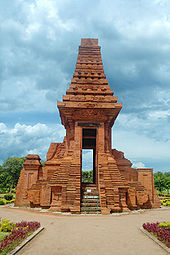 The elegant 16.5 metres tall Bajang Ratu gate, at Trowulan, echoed the grandeur of Majapahit.
The elegant 16.5 metres tall Bajang Ratu gate, at Trowulan, echoed the grandeur of Majapahit.
Majapahit recognize the hierarchy classifications of lands within its realm:
-
- Bhumi: the kingdom, ruled by the king
- Nagara: the province, ruled by the rajya (governor), or natha (lord), or bhre (prince or duke)
- Watek: the regency, administered by wiyasa,
- Kuwu: the district, administered by lurah,
- Wanua: the village, administered by thani,
- Kabuyutan: the hamlet or sanctuary place.
During its formation, Majapahit traditional realm only consists of lesser vassal kingdoms (provinces) in eastern and central Java. This region is ruled by provincial kings called Paduka Bhattara with the title Bhre. This title is the highest position below the monarch and similar to duke or duchess. Usually this position reserved for the close relatives of the king. Their duty is to administer their own provinces, collect taxes, send annual tributes to the capital, and manage the defenses of their borders.
During the reign of Hayam Wuruk (1350 to 1389) there were 12 provinces of Majapahit, administered by king's close relatives:
Provinces Titles Rulers Relation to the King Kahuripan (or Janggala, today Surabaya) Bhre Kahuripan Tribhuwanatunggadewi queen mother Daha (former capital of Kediri) Bhre Daha Rajadewi Maharajasa aunt and also mother in-law Tumapel (former capital of Singhasari) Bhre Tumapel Kertawardhana father Wengker (today Ponorogo) Bhre Wengker Wijayarajasa uncle and also father in-law Matahun (today Bojonegoro) Bhre Matahun Rajasawardhana husband of the duchess of Lasem, king's cousin Wirabhumi (Blambangan) Bhre Wirabhumi Bhre Wirabhumi1 son Paguhan Bhre Paguhan Singhawardhana brother in-law Kabalan Bhre Kabalan Kusumawardhani2 daughter Pawanuan Bhre Pawanuan Surawardhani niece Lasem (a coastal town in Central Java) Bhre Lasem Rajasaduhita Indudewi cousin Pajang (today Surakarta) Bhre Pajang Rajasaduhita Iswari sister Mataram (today Yogyakarta) Bhre Mataram Wikramawardhana2 nephew 1 Bhre Wirabhumi is actually the title: the Duke of Wirabhumi (Blambangan), the real name is unknown and he referred as Bhre Wirabhumi in Pararaton. He married to Nagawardhani, the king's niece.
2 Kusumawardhani (king's daughter) married to Wikramawardhana (king's nephew), the couple become the heir.
When Majapahit entered the thalassocratic imperial phase during the administration of Gajah Mada, several overseas vassal states were included within the Majapahit sphere of influence, as the result the new larger territorial concept was defined:
- Negara Agung, or the Grand State, the core kingdom. The traditional or initial area of Majapahit during its formation before entering the imperial phase. This includes the capital city and the surrounding areas where the king effectively exercises his government. This area covered the eastern half of Java, with all its provinces ruled by the Bhres (dukes), the king's close relatives.
- Mancanegara, areas surrounding Negara Agung. These areas are directly influenced by Javanese culture, and obliged to pay annual tributes. However these areas usually possess their own native rulers or kings, that might foster alliance or intermarried with the Majapahit royal family. Majapahit stationed their officials and officers in these places and regulate their foreign trade activities and collect taxes, yet they enjoyed substantial internal autonomy. This includes the rest of Java island, Madura, Bali, as well as Dharmasraya, Pagaruyung, Lampung and Palembang in Sumatra.
- Nusantara, areas which do not reflect Javanese culture, but are included as colonies and they had to pay annual tribute. They enjoyed substantial autonomy and internal freedom, and Majapahit did not necessarily station their officials or military officers here; however, any challenges on Majapahit oversight might draw severe response. These areas such as the vassal kingdoms and colonies in Maluku, Lesser Sunda Islands, Sulawesi, Borneo, and Malay peninsula.
All of those three categories were within the sphere of influence of the Majapahit empire, however Majapahit also recognize the fourth realm that defines its foreign diplomatic relations:
- Mitreka Satata, literary means "partners with common order". It refer to independent foreign states that is considered as Majapahit's equals, not the subject of Majapahit powers. According to Nagarakretagama canto 15, the foreign states are Syangkayodhyapura (Ayutthaya of Siam), Dharmmanagari (Nakhon Si Thammarat Kingdom), Marutma, Rajapura and Sinhanagari (kingdoms in Myanmar), Champa, Kamboja (Cambodia), and Yawana (Annam).[29] Mitreka Satata can be considered as Majapahit's allies, since other foreign kingdoms in China and India was not included in this category, although Majapahit known has conducted foreign relations with these nations.
In later period, Majapahit's hold on its overseas possessions began to waned. According to Wingun Pitu inscription (dated 1447) it was mentioned that Majapahit was consist of 14 provinces, that administrated by the ruler titled Bhre.[30] The provinces or vassal areas are:
- Kembang Jenar
- Matahun (today Bojonegoro)
- Pajang (today Surakarta)
- Singhapura
- Tanjungpura
- Tumapel (former capital of Singhasari)
- Wengker (today Ponorogo)
- Wirabhumi (today Blambangan)
Legacy
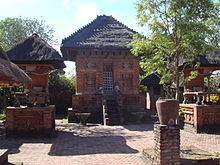 Pura Maospahit ("Majapahit Temple") in Denpasar, Bali, demonstrate the typical Majapahit red brick architecture.
Pura Maospahit ("Majapahit Temple") in Denpasar, Bali, demonstrate the typical Majapahit red brick architecture.
In sum, Majapahit was the largest empire ever to form in Southeast Asia. Although its political power beyond the core area in east Java was diffuse, constituting mainly ceremonial recognition of suzerainty, Majapahit society developed a high degree of sophistication in both commercial and artistic activities. Its capital was inhabited by a cosmopolitan population among whom literature and art flourished.[24]
Majapahit had a momentous and lasting influence on Indonesian architecture. The descriptions of the architecture of the capital's pavilions (pendopo) in the Nagarakertagama invoke the Javanese Kraton also the Balinese temples and palace compounds of today. The Majapahit architectural style that often employs terracotta and red brick had heavily influenced the architecture of Java and Bali in the later period. The Majapahit style candi bentar split gate, the kori or paduraksa towering red brick gate, and also pendopo pavilion has become ubiquitous in Javanese and Balinese architectural features, as evidence in Menara Kudus Mosque, Keraton Kasepuhan and Sunyaragi park in Cirebon, Mataram Sultanate royal cemetery in Kota Gede, Yogyakarta, and various palaces and temples in Bali.
The vivid, rich and festive Balinese culture is considered as one of Majapahit legacy. The Javanese Hindu civilization since the era of Airlangga to the era of Majapahit kings has profoundly influenced and shaped the Balinese culture and history.[31] The ancient links and Majapahit legacy is observable in many ways; architecture, literature, religious rituals, dance-drama and artforms. The aesthetics and style of bas-reliefs in Majapahit East Javanese temples were preserved and copied in Balinese temples. It is also due to the fact that after the fall of the empire, many Majapahit nobles, artisans and priests has took refuge either in the interior mountainous region of East Java or across the narrow strait to Bali. Large numbers of Majapahit manuscripts, such as Nagarakretagama, Sutasoma, Pararaton and Tantu Pagelaran, were being well-kept in royal libraries of Bali and Lombok, and provides the glimpse and valuable historical records on Majapahit. The Majapahit Hindu-Javanese culture has shaped the culture of Bali, that led to popular expression; "without Java there is no Bali". Yet in return, Bali is credited as the last stronghold to safeguard and preserved the ancient Hindu Javanese civilization.
In weaponry, the Majapahit expansion is believed to be responsible for the widespread use of the keris dagger in Southeast Asia; from Java, Bali, Sumatra, Malaysia, Brunei, Southern Thailand, to the Philippines. Although it has been suggested that the keris, and native daggers similar to it, predate Majapahit, nevertheless the empire expansion contributed to its popularity and diffussion in the region.
For Indonesians in later centuries, Majapahit became a symbol of past greatness. The Islamic sultanates of Demak, Pajang, and Mataram sought to establish their legitimacy in relation to the Majapahit.[32] The Demak claimed a line of succession through Kertabumi, as its founder, Raden Patah, in court chronicles was said to be the son of Kertabumi with Putri Cina, a Chinese princess, who had been sent away before her son was born.[22] Sultan Agung's conquest of Wirasaba (present day Mojoagung) in 1615 — during that time just a small town without significant strategic and economic value — led by the sultan himself, may probably have had such symbolic importance as it was the location of the former Majapahit capital.[33] Central Javanese palaces have traditions and genealogy that attempt to prove links back to the Majapahit royal lines — usually in the form of a grave as a vital link in Java — where legitimacy is enhanced by such a connection.[citation needed] Bali in particular was heavily influenced by Majapahit and the Balinese consider themselves to be the true heirs of the kingdom.[25]
The high reliefs of Gajah Mada and Majapahit history depicted in Monas, has become the source of Indonesian national pride of past greatness.
Modern Indonesian nationalists, including those of the early 20th century Indonesian National Revival, have invoked the Majapahit Empire. The memory of its greatness remains in Indonesia, and is sometimes seen as a precedent for the current political boundaries of the Republic.[4] Many of modern Indonesian national symbols derived from Majapahit Hindu-Buddhist elements. The Indonesian national flag "Sang Merah Putih" ("Red and White") or sometimes called "Dwiwarna" ("The bicolor"), derived from the Majapahit royal color. The Indonesian Navy flag of red and white stripes also has a Majapahit origin. The Indonesian national motto, "Bhinneka Tunggal Ika", is a quotation from an Old Javanese poem "Kakawin Sutasoma", written by a Majapahit poet, Mpu Tantular.[34]
The Indonesian coat of arms, Garuda Pancasila, also derives from Javanese Hindu elements.[35] The statue and relief of Garuda have been found in many temples in Java such as Prambanan from the ancient Mataram era, and the Panataran as well as the Sukuh temple dated from the Majapahit era. The notable statue of Garuda is the statue of the king Airlangga depicted as Vishnu riding Garuda.
In its propaganda from the 1920s, the Communist Party of Indonesia presented its vision of a classless society as a reincarnation of a romanticized Majapahit.[36] It was invoked by Sukarno for nation building and by the New Order as an expression of state expansion and consolidation.[37] Like Majapahit, the modern state of Indonesia covers vast territory and is politically centred on Java.
Palapa, the series of communication satellites owned by Telkom, an Indonesian telecommunication company, has been named after Sumpah Palapa, the famous oath taken by Gajah Mada. Gajah Mada swore that he would not taste any spice as long as he had not succeeded in unifying Nusantara (Indonesian archipelago). This ancient oath of unification signifies the Palapa satellite as the modern means to unify the Indonesian archipelago by way of telecommunication. The name was chosen by president Suharto, and the program was started in February 1975.
During the last half year of 2008, the Indonesian government sponsored a massive exploration on the site that is believed to be the place where the palace of Majapahit once stood. Jero Wacik, the Indonesian Minister of Culture and Tourism stated that the Majapahit Park would be built on the site and completed as early as 2009, in order to prevent further damage caused by home-made brick industries that develop on the surrounding area.[38] Nevertheless, the project leaves a huge attention to some historians, since constructing the park's foundation in Segaran site located in south side of Trowulan Museum will inevitably damage the site itself. Ancient bricks which are historically valuable were found scattered on the site. The government then argued that the method they were applying were less destructive since digging method were used instead of drilling.[39]
List of rulers
The rulers of Majapahit was the dynastic continuity of the Singhasari kings, which started by Sri Ranggah Rajasa, the founder of Rajasa dynasty in late 13th century.
- Raden Wijaya, styled Kertarajasa Jayawardhana (1294–1309)
- Kalagamet, styled Jayanagara (1309–1328)
- Sri Gitarja, styled Tribhuwana Wijayatunggadewi (1328–1350)
- Hayam Wuruk, styled Sri Rajasanagara (1350–1389)
- Wikramawardhana (1389–1429)
- Suhita (1429–1447)
- Kertawijaya, styled Brawijaya I (1447–1451)
- Rajasawardhana, born Bhre Pamotan, styled Brawijaya II (1451–1453)
- Interregnum (1453–1456)
- Bhre Wengker, Purwawisesa or Girishawardhana, styled Brawijaya III (1456–1466)
- Singhawikramawardhana, Pandanalas, or Suraprabhawa, styled Brawijaya IV (1466 - 1468 or 1478[8])
- Kertabumi, styled Brawijaya V (1468–1478)
- Girindrawardhana, styled Brawijaya VI (1478–1498)
Majapahit in popular culture
Celebrated as 'the golden era of the archipelago', the Majapahit empire has inspired many writers and artists (and continues to do so) to create their works based on this era, or to describe and mention it. The impact of the Majapahit theme on popular culture can be seen in the following:
- Sandyakalaning Majapahit (1933), or Twilight/Sunset in Majapahit is an historical romance that took place during the fall of Majapahit empire, written by Sanusi Pane.
- Panji Koming (since 1979), a weekly comic strip by Dwi Koendoro published in the Sunday edition of Kompas, telling the everyday life of Panji Koming, a common Majapahit citizen. Although it took place in the Majapahit era, the comic strip serves as witty satire and criticism of modern Indonesian society. From a political, social, cultural and current point of view, Indonesia is described as the 'reincarnation' of the Majapahit empire. The current Indonesian president is often portrayed as a Majapahit monarch or prime minister.
- Saur Sepuh (1987–1991), a radio drama and film by Niki Kosasih. Begun as a popular radio drama program in the late 1980s, Saur Sepuh is based on 15th century Java, centered around the story about a fictional hero named Brama Kumbara, the king of Madangkara, a fictional kingdom neighbour of the Pajajaran. In several stories the Paregreg war is described, that is to say the civil war of Majapahit between Wikramawardhana and Bhre Wirabhumi. This part has been made into a single feature film entitled 'Saur Sepuh' as well.
- Tutur Tinular, a radio drama and film by S Tidjab. Tutur Tinular is a martial art historical epic fictional story with the Majapahit era serving as the background of the story. The story also involved a romance between the hero named Arya Kamandanu and his Chinese lover Mei Shin.
- Wali Songo, the film tells the story of nine Muslim saints ('wali') who spread Islam to Java. The story took place near the end of the Majapahit era and the formation of Demak. It describes the decaying Majapahit empire where royals are fighting each other for power, while commoners are suffering.
- Senopati Pamungkas (1986, reprinted in 2003), a novel by Arswendo Atmowiloto that is also a martial art-historical epic fiction. It took place in the late Singhasari period and formation of Majapahit. This novel describes the saga, royal intrigue, and romance of the formation of the Majapahit kingdom as well as the adventure of the main character, a commoner named Upasara Wulung and his forbidden love affair with princess Gayatri Rajapatni, whom later becomes the consort of Raden Wijaya, the first king of Majapahit.
- Imperium Majapahit, a comic book series by Jan Mintaraga, published by Elexmedia Komputindo. This series tells the history of Majapahit from its formation until the decline.
- Puteri Gunung Ledang (2004), a Malaysian epic film based on a traditional Malay legend. This film recounts the love story between Gusti Putri Retno Dumilah, a Majapahit Princess, and Hang Tuah, a Malaccan admiral.
- Gajah Mada, a pentalogy written by Langit Kresna Hariadi, about fictionalized detail of Gajah Mada's life from Kuti rebellion until Bubat War.
- Dyah Pitaloka (2007), a novel written by Hermawan Aksan, about the fictionalized detailed lifestory of Sundanese Princess Dyah Pitaloka Citraresmi, focussed around the Bubat War. The novel virtually took the same context and was inspired by Kidung Sundayana.
See also
- Kidung Sunda
- Osing
- Tenggerese
- List of monarchs of Java
Notes
- ^ D.G.E. Hall (1956). "Problems of Indonesian Historiography". Pacific Affairs (Pacific Affairs, Vol. 38, No. 3/4) 38 (3/4): 353–359. doi:10.2307/2754037. JSTOR 2754037.
- ^ Keat Gin Ooi (2004). Southeast Asia: a historical encyclopedia, from Angkor Wat to East Timor, Volume 1. ABC-CLIO. pp. 822. ISBN 9781576077702. http://books.google.com/books?id=QKgraWbb7yoC&pg=PA822.
- ^ Majapahit Overseas Empire, Digital Atlas of Indonesian History
- ^ a b c d e f Ricklefs (1991), page 19
- ^ Prapantja, Rakawi, trans. by Theodore Gauthier Pigeaud, Java in the 14th Century, A Study in Cultural History: The Negara-Kertagama by Rakawi Prapanca of Majapahit, 1365 AD (The Hague, Martinus Nijhoff, 1962), vol. 4, p. 29. 34; G.J. Resink, Indonesia’s History Between the Myths: Essays in Legal History and Historical Theory' (The Hague: W. van Hoeve, 1968), p. 21.
- ^ The Brunei Museum journal, Volume 4, Issue 1 - Page 192
- ^ Taylor, Jean Gelman (2003). Indonesia: Peoples and Histories. New Haven and London: Yale University Press. pp. 29. ISBN 0-300-10518-5.
- ^ a b c d e Ricklefs (1991), page 18
- ^ Johns, A.H. (November 1964). "The Role of Structural Organisation and Myth in Javanese Historiography". The Journal of Asian Studies (The Journal of Asian Studies, Vol. 24, No. 1) 24 (1): 91–99. doi:10.2307/2050416. JSTOR 2050416.
- ^ C. C. Berg. Het rijk van de vijfvoudige Buddha (Verhandelingen der Koninklijke Nederlandse Akademie van Wetenschappen, Afd. Letterkunde, vol. 69, no. 1) Ansterdam: N.V. Noord-Hollandsche Uitgevers Maatschappij, 1962; cited in M.C. Ricklefs, A History of Modern Indonesia Since c. 1300, 2nd ed. Stanford: Stanford University Press, 1993, pages 18 and 311
- ^ Ma Huan Ying-yai Sheng-lan, translated by J.V.G Mills, White Lotus p86 ISBN 974-8496-78-4
- ^ JakartaPost: Majapahit capital may be larger than previously believed
- ^ Spuler, Bertold; F.R.C Bagley (1981). The Muslim world : a historical survey, Part 4. Brill Archive. pp. 252. ISBN 9004061967, 9789004061965. http://books.google.com.my/books?id=VNgUAAAAIAAJ.
- ^ a b Slamet Muljana. Menuju Puncak Kemegahan (LKIS, 2005)
- ^ Munoz, Paul Michel (2006). Early Kingdoms of the Indonesian Archipelago and the Malay Peninsula. Singapore: Editions Didier Millet. pp. 279. ISBN 9814155675.
- ^ Drs. R. Soekmono, (1973, 5th reprint edition in 1988). Pengantar Sejarah Kebudayaan Indonesia 2, 2nd ed.. Yogyakarta: Penerbit Kanisius. p. 72.
- ^ Y. Achadiati S, Soeroso M.P., (1988). Sejarah Peradaban Manusia: Zaman Majapahit.. Jakarta: PT Gita Karya. p. 13.
- ^ Millet, Didier (Hardcover edition — August 2003). John Miksic. ed. Indonesian Heritage Series: Ancient History. Singapore 169641: Archipelago Press. pp. 106. ISBN 981-3018-26-7.
- ^ Cribb, Robert, Historical Atlas of Indonesia, University of Hawai'i Press, 2000
- ^ Ricklefs, 37 and 100
- ^ Poesponegoro & Notosusanto (1990), hal. 448-451.
- ^ a b Ricklefs, 36-37
- ^ Robert W. Hefner (1983). "Ritual and Cultural Reproduction in Non-Islamic Java". American Ethnologist 10 (1983): 665–683. doi:10.1525/ae.1983.10.4.02a00030. JSTOR 644055.
- ^ a b c d e Millet, Didier (Hardcover edition — August 2003). Indonesian Heritage Series: Ancient History. editor: John Miksic. Singapore 169641: Archipelago Press. pp. 107. ISBN 981-3018-26-7.
- ^ a b Schoppert, P., Damais, S. (1997). Didier Millet. ed. Java Style. Paris: Periplus Editions. pp. 33–34. ISBN 962-593-232-1.
- ^ "Ritual Networks and Royal Power in Majapahit Java, page:100". Persee. 1996. http://www.persee.fr/web/revues/home/prescript/article/arch_0044-8613_1996_num_52_1_3357. Retrieved 2010-07-14.
- ^ "Uang Kuno Temuan Rohimin Peninggalan Majapahit". November 2008. http://www.kompas.com/read/xml/2008/11/24/17571290/uang.kuno.temuan.rohimin.peninggalan.majapahit..
- ^ Poesponegoro & Notosusanto (1990), hal. 451-456.
- ^ MAJAPAHIT : KERAJAAN AGRARIS - MARITIM DI NUSANTARA page 8
- ^ Nastiti, Titi Surti. Prasasti Majapahit, in the site www.Majapahit-Kingdom.com from Direktorat Jenderal Sejarah dan Purbakala. Friday, 22 June 2007.
- ^ Lonely Planet: History of Bali
- ^ Ricklefs, page 40
- ^ Ricklefs, page 43
- ^ Bhinneka Tunggal Ika, masterpiece of Mpu Tantular, Antara (in Indonesian)
- ^ Hindu Civilizations of Austronesia and Southeast Asia
- ^ Ricklefs, page 174
- ^ Friend, Theodore. Indonesian Destinies. Cambridge, Massachusetts and London: Belknap Press, Harvard University Press. pp. 19. ISBN 0-674-01137-6.
- ^ "Taman Majapahit Dibangun di Trowulan". November 4, 2008. http://www.kompas.com/read/xml/2008/11/04/20305699/taman.majapahit.dibangun.di.trowulan.
- ^ "Situs Majapahit Dirusak Pemerintah". January 5, 2009. http://www.kompas.com/read/xml/2009/01/05/05100324/situs.majapahit.dirusak.pemerintah.
References
- M.C. Ricklefs, A History of Modern Indonesia Since c. 1300, 2nd ed. Stanford: Stanford University Press, 1991
External links
Categories:- Former monarchies
- Former countries in Southeast Asia
- States and territories established in 1293
- States and territories disestablished in 1527
- 1527 disestablishments
- Indianized kingdoms
- Historical Hindu empires
- Pre-colonial States of Indonesia
- 1293 establishments
- Former countries in Malaysian history
- Former countries in Philippine history
- Majapahit
- Former empires of Asia
- Former countries in Indonesian history
-
Wikimedia Foundation. 2010.


